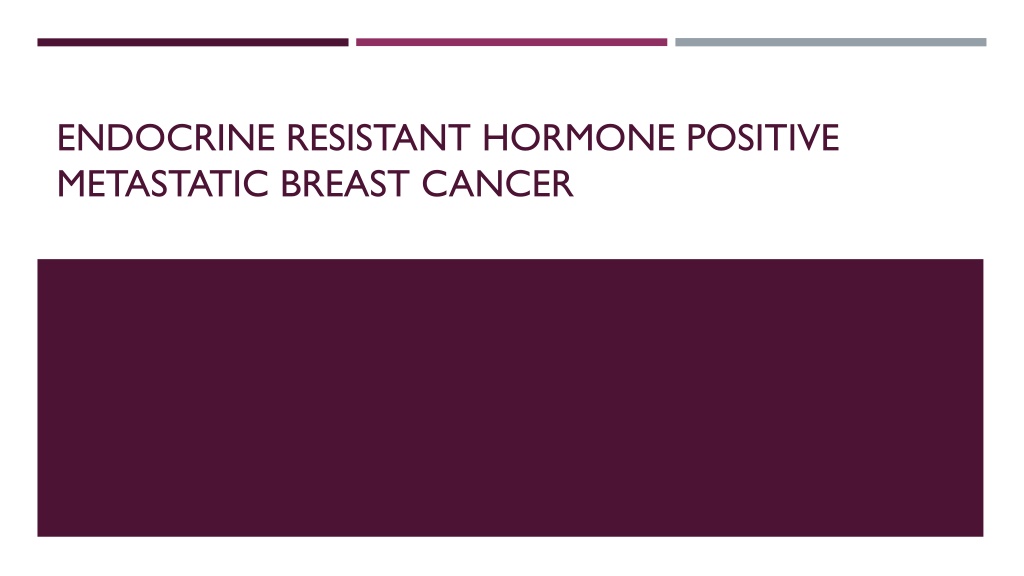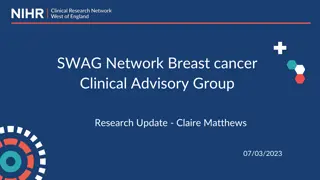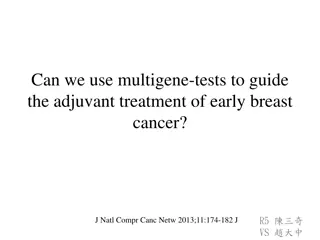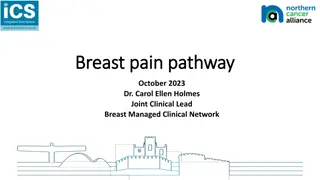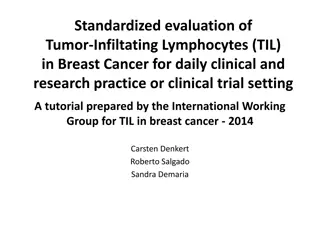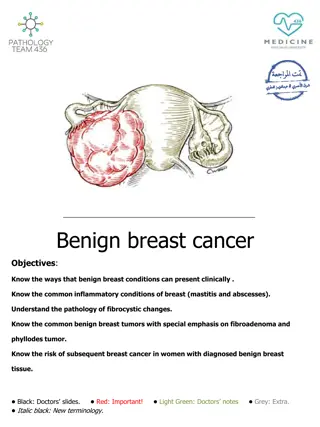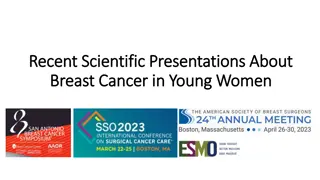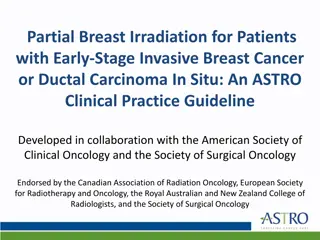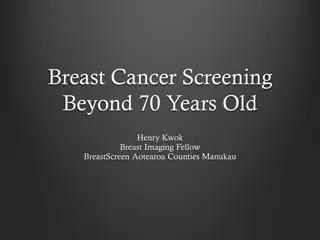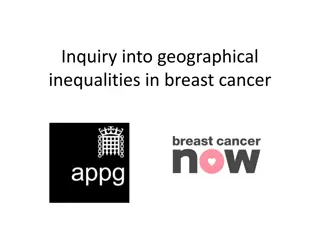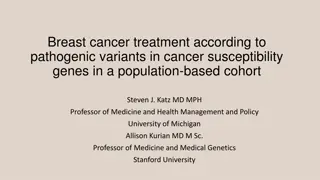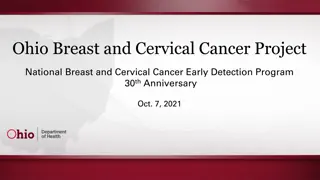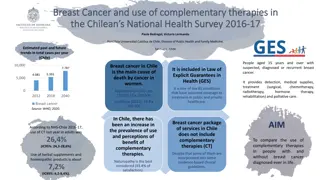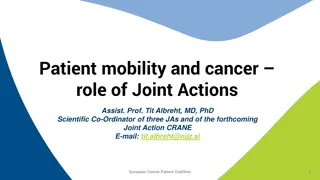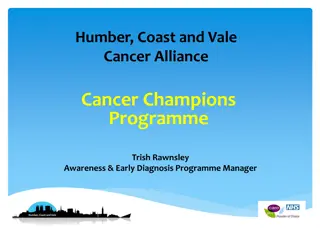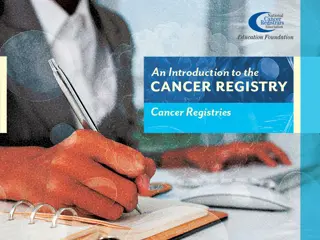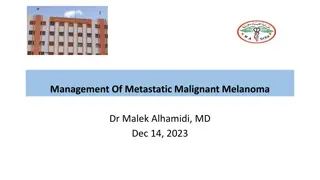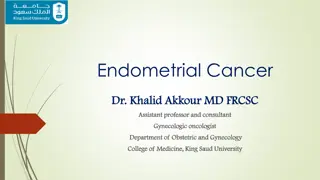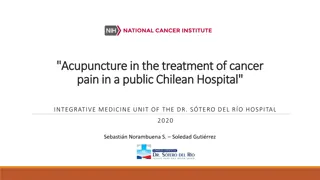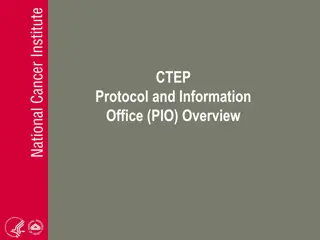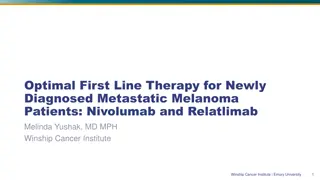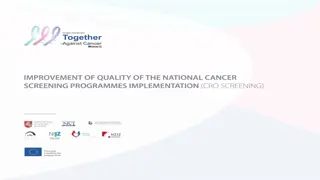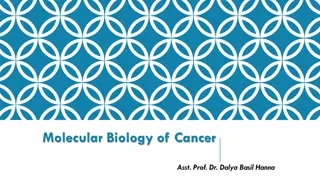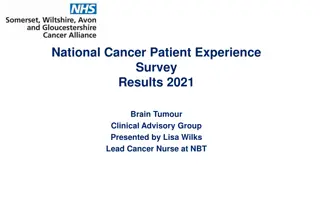Metastatic Breast Cancer Treatment and Progression Overview
Mrs. GV, a 78-year-old woman with endocrine-resistant hormone-positive metastatic breast cancer, presented with dyspnea. Her medical history includes chronic fatigue syndrome, hypothyroidism, and hypertension. Disease progression led to dermal and intraocular metastasis, managed with treatments like Letrozole, Tamoxifen, Bondronat, and Abraxane. Despite endocrine therapy resistance, the patient's condition remains stable. Various imaging and treatment strategies have been employed to address the metastatic spread.
Download Presentation

Please find below an Image/Link to download the presentation.
The content on the website is provided AS IS for your information and personal use only. It may not be sold, licensed, or shared on other websites without obtaining consent from the author. Download presentation by click this link. If you encounter any issues during the download, it is possible that the publisher has removed the file from their server.
E N D
Presentation Transcript
ENDOCRINE RESISTANT HORMONE POSITIVE METASTATIC BREAST CANCER
HOPC Mrs GV is a 78 year old women who presented to Cabrini ED with acute dyspnoea is the setting of recent malignant pleural effusion in the setting of Metastatic Breast Ca. Nov 2010: Self Detected left breast lump (AJCC Stage IIa -T1 N1 M0) WLE + SLNBX: 16mm BRE Gr 3 IDC w focal mucinous differentiation ER/PR Positive +++; HER-2 Negative. Multifocal LVI. Nil perineural invasion. Clear margins. Node positive disease: 8mm focus in 1/3 SLN Further Axillary Dissection: 0/6 nodes Jan 2011: Adjuvant Radiotherapy Feb 2011: Letrozole/Risedronate Chemotherapy not commenced in setting of severe CFS + chemical sensitivities
BACKGROUND PMHX Chronic Fatigue Syndrome Hypothyroidism Hypertension Hysterectomy (menorrhagia) Osteoporosis Menopause (HRT for 15 years) SHX Home-maker From home alone (supportive daughter lives very close) Widow (2001) ; Children x3 (Daughter-Brighton; Sons-Brunswick/San Francisco) Life long non smoker- although heavy passive smoker via Husband Non-drinker FHX Uncle: Lung Cancer (77yo) Heavy smoker Niece: Breast Ca (46yo)
DISEASE PROGRESSION Aug 2011: Ceased Letrozole due to arthralgia/flushing. Declined further endocrine treatment. Aug 2012: Left Anterior Chest Wall pain and Ca 15.3 rise: 199 (B/L~20) Scans delayed due to subsequent OS holiday Oct 2012 (CT CAP): multiple nodules throughout both lung fields and extensive mediastinal lymphadenopathy with evidence of calcification. There were no abnormalities below the diaphragm. (Whole body bone scan): abnormal activity in the sternum, the left pubic bone, the T4 vertebral body, left 8th rib - all consistent with bone metastases. The histopathology (left supraclavicular lymph node) biopsy confirms metastatic spread from breast cancer with the same hormonal profile with oestrogen and progesterone receptors both being strongly positive. Tamoxifen / Bondronat
Oct 2013: Dermal metastatic spread started on Abraxane Apr 2014: Completed six cycles of Abraxane. CT scan: stable appearance of her mediastinal lymph node metastases with a very small right pleural effusion. Her bony metastatic disease is stable. June 2014: Intraocular metastasis Rx w RT Mid Sept: Gemcitabine/Carboplatin Late Sept 2014: Right Pleural Effusion
ENDOCRINE THERAPY RESISTANCE IN ER POSITIVE METASTATIC BREAST CANCER
There are three different types of hormonal therapy medicines: Aromatase inhibitors: Arimidex (chemical name: anastrozole) Aromasin (chemical name: exemestane) Femara (chemical name: letrozole) SERMs (Selective Estrogen Receptor Modulators): Tamoxifen Fareston (chemical name: toremifene) ERDs (OEstrogen Receptor Downregulators): Faslodex (chemical name: fulvestrant)
Premenopausal Postmenopausal Peripheral Sites: adrenal gland, liver, muscle, fat Ovaries Ovarian Suppression Aromatase Inhibitors GnRH inhibitors or Ovarian removal Oestrogen Tamoxifen Tamoxifen ER ER X Fulvestrant Cancer Cell
OESTROGENS Oestrogens play a crucial role in breast tumor growth rationale for the use of antioestrogens, such as tamoxifen, in women with estrogen receptor (ER)- -positive breast cancer. However, hormone resistance is a major clinical problem. Intrinsic and acquired Heterogenous Altered growth factor signalling to the ER pathway has been shown to be associated with the development of clinical resistance.
KAROLINSKA COHORT: INTRA-INDIVIDUAL ER STATUS AT RELAPSE Aim Determine if hormone receptor and HER2 status change between primary breast cancer and relapse Methods N = 1051 breast cancer patients relapsing between 1997-2007 at single center in Stockholm, Sweden Hormone receptor and HER2 status gathered from original patient records Lindstrom L, et al. SABCS 2010. Abstract S3-5.
KAROLINSKA COHORT: INTRA-INDIVIDUAL ER STATUS AT RELAPSE Lindstrom L, et al. SABCS 2010. Abstract S3-5.
ER RESISTANCE Crosstalk between ER and critical signalling pathways epidermal growth factor receptor/human epidermal growth factor receptor 2 (HER2) extracellular signal-regulating kinase 1/2/mitogen activated protein kinase cascade phosphoinositide 3-kinase (PI3K)/protein kinase B (AKT)/mammalian target of rapamycin (mTOR) pathway/fibroblast growth factor receptor 1/2 [FGFR]/ insulin- like growth factor-1 receptor [IGF-1R] Johnston SR, et al 2005; Steroid Biochem Mol Biol 95:173 181 Johnston SRD 2010; Clinical Cancer Res 16:1979 1987
OVERCOMING ENDOCRINE RESISTANCE: BOLERO 2 Phase III study Population 724 postmenopausal women with hormone receptor (HR) positive, HER2-negative metastatic breast cancer that had progressed on therapy with a nonsteroidal aromatase inhibitor Intervention Combination therapy with exemestane and mTOR inhibitor everolimus vs exemestane Results Significantly longer progression-free survival (7.8 months v 3.2 mth) and higher response rate than single-agent exemestane. Baselga J et al N Eng J Med 2012;366:520-529
OVERCOMING ENDOCRINE RESISTANCE: TAMRAD Randomised phase II trial Patient population 111 patients with HR+/HER2- metastatic breast cancer with prior exposure to AI treatment (in adjuvant and/or metastatic setting) Intervention Tamoxifen/Everolimus (n=57) vs Tamoxifen alone (n=54) Results Tamoxifen/everolimus had a higher clinical benefit rate (61%) and longer time to progression (8.6 months) than the group receiving tamoxifen alone (42% and 4.5 months). Patients with secondary resistance to AI seemed to benefit more from the combination than patients with primary resistance. Bachelot T, et al 2012; J Clin Oncol 30:2718 2724.
OVERCOMING ENDOCRINE RESISTANCE: HORIZON Multinational randomised phase III trial Population 1112 aromatase inhibitor naive women with hormone receptor-positive advanced disease Intervention Temsirolimus/Letrozole vs Letrozole/placebo Results Stopped for futility by the independent data monitoring committee. Response rate and overall survival were also similar between groups Wolff AC, et al 2013; J Clin Oncol 31:195 202.
IN CONCLUSION ER-positive disease is heterogeneous endocrine resistance is a complex problem - needs highly translational trials to solve. Targeting mTOR should be limited to populations with acquired AI resistance and should use everolimus, not others in the class. From a research perspective, we know that careful choice of compounds and combinations based on biologic and Further pharmacogenomics may shed light on patient differences, and biomarker analysis on most if not all patients in clinical trials of novel targeted agents and combinations is essential.
